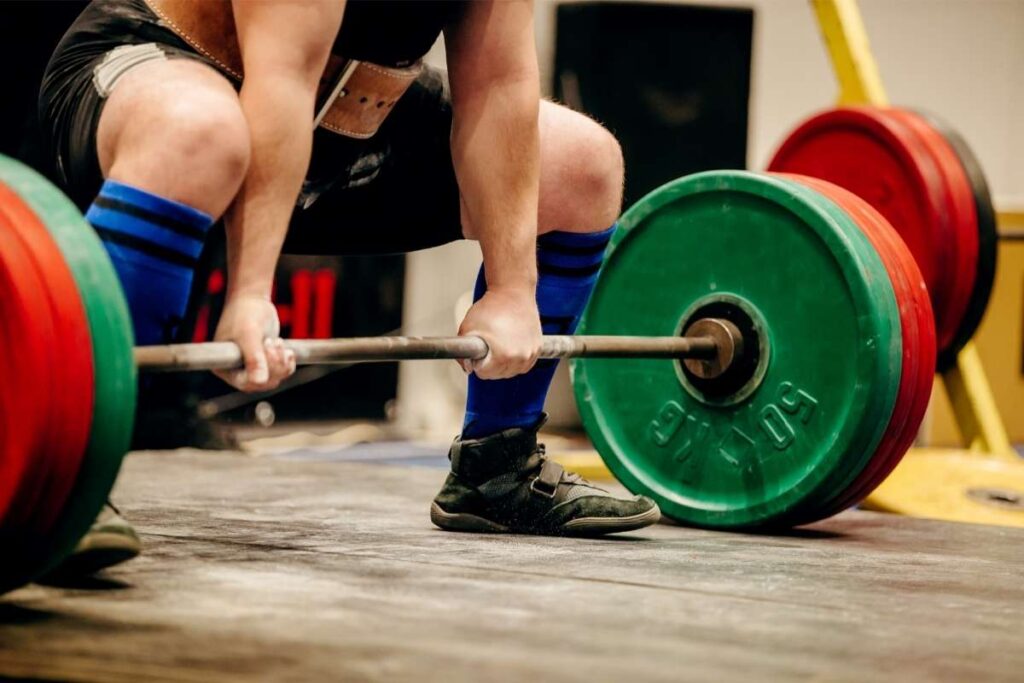This post may contain affiliate links at no additional cost to you. As an Amazon Associate I earn from qualifying purchases. Click to view our full disclosure.
What's inside
The gym can be an interesting place where people from all different walks of life meet.
Just like other recreational activities, there is certain slang associated with the environment.
If you’re new to the gym, this can sound like rambling bro talk that goes way over your head. From the gym bros to the powerlifters and the athletes, the list of terms seems endless.
While some of it is nonsense, many phrases are apt terms that can be an effective way of describing your training.
Today, I am going to discuss 57 gym slang terms to help you interpret and identify gym jargon.
Let’s jump in.
1. Yolked
Yolked is a term used to describe the large muscle mass surrounding the neck and trapezius, typically used with bodybuilders and powerlifters.
2. Newbie Gains

Newbie gains, also known as “noob gains,” refer to the initial muscle growth that happens when new gym goers begin training in the gym.
3. DOMs
DOMs stands for Delayed Onset Muscle soreness. It refers to the tenderness of muscle tissue following intense resistance training.
4. Pump

The “pump” is a term used to describe the feeling when a working muscle has increased in size due to enhanced blood flow. “He felt the pump after doing his bicep curls.”
5. Spotter
A spotter is someone who is on standby while some complete their lifts. These people are there to assist with a gentle pull when the lifter is struggling with their remaining reps.
6. Ectomorphs/Ecto-mesomorphs
The term ectomorph refers to a skinnier body type that is narrow in the shoulders and hips. This body type finds it difficult to put on weight due to its fast metabolism.
7. Mesomorphs/Meso-endomorphs
Mesomorph describes a body type of a medium build, typically with shoulders wider than hips. These individuals present an athletic build and find it easier to gain muscle than other body types.
8. Endomorphs/Ecto-Endomorphs
Endomorphs is a term used to illustrate a heavier build, with larger shoulders and hips. These individuals can have increased muscle mass, however with added body fat.
9. Ottermode
Ottermode is a term used to describe the lean and muscular physique like that of a swimmer.
10. Bear Mode
Bear mode refers to an increase in body weight to increase muscle growth and improve performance.
11. Cutting
Cutting is a term used to describe the reduction of body fat and the process of leaning out. This is done by bodybuilders leading up to a competition to display their muscle mass.
12. Lean Bulking

Lean bulking refers to increasing body mass by means of increasing calories through healthy food choices. This is done by eating unprocessed, nutrient and calories-dense food.
13. Skinny-Fat
Skinny-fat is a term used to describe a body type where the body, including the shoulders, hips, and extremities is skinny, but the abdominal region is carrying body fat.
14. Bulking
Bulking is a term used to describe the increase of body weight through calorie surplus to build muscle mass.
15. Swole
Swole is used to describe someone’s muscles, muscle mass, or physique. Think of swollen muscles.
16. Jacked
Jacked is slang for looking big and muscular. “How’s your training going? You look jacked!”
17. Ripped
“Ripped” is used to describe some with lean, well-defined muscle. “I saw her yesterday, she looks ripped.”
18. Shredded

Shredded is used to describe someone who is incredibly lean and muscular. “Wow, you look shredded.”
19. Bodybuilding
Bodybuilding refers to progressively overloading muscles to promote muscle hypertrophy (increase muscle mass) either for personal growth or for competing.
20. Body Recomposition

Body recomposition refers to the changing of physique through weight loss and increasing muscle mass. This is done by increasing protein, boosting metabolism, and progressively overloading the body.
21. Plateau
Plateau refers to your progressive overloading being stuck at a certain weight for weeks.
22. To Failure
“To failure” refers to training until you can no longer perform another repetition and must release or drop the weight as a result.
23. Form
Form refers to the technique of an exercise. “If you don’t correct your form you’re going to get hurt.”
24. Warm-Up
A warm-up is the warming up of the body prior to exercising. This can be done either on a piece of cardio equipment for a few minutes or by performing a light set to prepare the body for an upcoming movement.
25. Reps
Reps are short for repetitions and refer to the number of times you perform each exercise.
26. One Rep Max
One rep max, one repetition maximum, or 1RM refers to the maximum weight that a person can lift for one repetition.
27. Personal Best (PB)

Personal best or PB means your highest weight, fastest time, or number of reps for a given exercise, drill, or movement in the gym. “My PB for the deadlift is 200 lbs.”
28. Half Reps
Half reps or half repetitions refers to performing an exercise and only taking the repetition through half of its range of motion.
29. Sets
Sets are the group of repetitions performed for an exercise. For example, she completed one set of 12 repetitions and another two sets of eight repetitions.
30. Accentuated Eccentric Sets
Accentuated eccentric sets refer to completing sets with a focus on the lowering or eccentric phase of the movement.
Research has indicated that this can be beneficial for developing higher concentric force production.
31. Paired Sets
Paired sets refer to pairing an agonist and antagonist or non-competing exercise together in succession.
An example of this is a chest and a back, where you perform the exercise with a short rest in between. This reduces time in the gym.
32. High-Rep, Light-Weight Sets

High-rep, light-weight sets are a type of training prescribed to improve muscular endurance. While heavy weight and low reps promote strength, lighter weight with higher reps is used to fatigue the muscle.
33. Drop Set
The drop set is a type of training where you perform a number of sets on one overarching set, dropping the weight with each subsequent set.
For example, you would perform the first set at six reps at 175 lbs., the second set of 10 reps at 130 lbs., and the third set of 12 reps at 90 lbs. You reduce the weight as you move through each set.
34. Super Set
Super set refers to performing two exercises one after another that target the same or similar muscle groups with no rest in between. This could be bench presses and push-ups, or cable row and bicep curls.
35. Full Range of Motion
Full range of motion is when you perform the movement or exercise through the joint’s complete range.
An example of this is with the bench press, lowering the barbell down to the chest and then back up until your arms are straight.
36. Negatives
Negative is a type of training that focuses on the eccentric loading of the muscle. A prime example of this would be the negative chin-up. Here you would jump to the top and gradually lower yourself until your arms are straight, and repeat.
37. Training Frequency
Related: How Many Exercises Per Workout?

Training frequency refers to the number of sessions you are completing per week and/or the number of times you train a muscle group per week.
38. Rest Period
The rest period is described as the amount of rest you have between sets. For strength, this is one to three minutes, and for muscle hypertrophy 30-60 seconds.
39. Intervals
Interval is a term used when describing bursts of exercises such as sprints on cardio equipment. “For your training I want you to complete 15 minutes of cardio with intervals of 20-second sprints followed by 40 seconds of rest.”
40. Workout Splits
Workout split refers to a split routine where a different body part, muscle group, or movement is trained on different days of the week. This can be the push/pull split. the bro split, or the upper/ lower split.
41. Horizontal Pull
Horizontal pull refers to the pulling of resistance in a horizontal plane. An example of this is the cable row or seated row where the cable is pulled horizontally away from resistance toward the body.
42. Vertical Pull
Related: 10 Best Vertical Pull Exercises

Vertical pull refers to the pulling of resistance in a vertical plane either from overhead or from the floor. Movements such as pull-ups, lat pulldowns, and bent-over rows are all considered vertical pulls.
43. Incline
Incline refers to the angle of the body when lying on a bench, like that of an incline bench press or incline dumbbell press. It’s where the lifter lies back at a 90-degree angle.
44. Decline
Decline refers to the angle of the body when it is below horizontal or parallel, like that of a decline bench press.
45. Macros/Micros
Macro is a term that is used when describing macronutrients including carbohydrates, protein, and fat. Micro refers to micronutrients such as magnesium, iron, and zinc.
46. Calories
Calories are a unit of energy that is used to describe the amount of energy a food provides. “This protein powder has 100 calories per scoop.”
47. Flexibility

Flexibility is the ability of joints or a number of joints to move through a range of motion without restriction.
48. Cardio
Cardio is short for cardiovascular exercise, which refers to exercises that raise the heart rate and respiratory system. Exercises such as running, rowing, and cycling are all examples of cardio.
49. Isolation Exercises
Isolation exercises are movements that target one muscle group. Common examples are bicep curls and tricep pushdowns.
50. Compound Exercises
Compound exercises are exercises that engage multiple joints and muscle groups to perform a movement. Prime examples of this are the bench press, deadlift, and squat which use many muscle groups of the body to perform a movement.
51. 5×5 Workout
The 5×5 workout is a strength-based workout where you perform 5 sets of 5 repetitions, gradually increasing weight with each set.
52. Pyramid Training
Pyramid training is when you perform the exercise, increasing weight with each set, with little to no rest in between.
An example of a bench press pyramid would be the first set of 12 reps at 110 lbs., the second set of 10 reps at 130 lbs., and the third set of eight reps at 150 lbs.
53. Reverse Pyramid
Reverse pyramid training is where you perform an exercise with follow-up sets reading weight with each following set. An example of this is a squat. The first set is six reps at 170 lbs., the second set is eight reps at 150 lbs., and the third set is 10 reps at 130 lbs.
54. Resistance Training

Resistance training refers to weight training, where you lift or move weight against resistance to strengthen the body.
55. Strength Training
Strength training is another way of referring to resistance training – it simply helps you to improve your strength.
Research has shown that performing a set of at least one to five repetitions can be beneficial for increasing strength.
56. Weight Training
Like strength and resistance training, weight training is the use of weight or resistance to strengthen the muscle of the body and increase muscle mass.
57. Hypertrophy Training
Hypertrophy training is a scientific term for increasing the size of a muscle through progressive overloading of the muscle. It is recommended that sets of 8-12 are required to promote muscle hypertrophy.
58. Interval Training
Interval training refers to high-intensity cardio training performed in intervals. An example of this is performing 20-second sprints with steady rowing.
59. Powerlifting

Powerlifting is a type of training and sport that requires the participant to lift a heavy weight off the floor with maximum effort. This centered around the major compound lifts squats, deadlifts, bench presses, and Olympic lifts.
60. Powerbuilding
Powerbuilding refers to a type of training that takes principles of both powerlifting and bodybuilding to increase strength and muscle mass.
61. Calisthenics
Calisthenics is a type of training that uses the body’s weight for resistance. This uses exercises such as push-ups, pull-ups, and squats to improve endurance and increase strength.
62. Circuit Training
Circuit training is when you have a number of exercises set up and you perform them in the form of a circuit. This allows you to move from one exercise to the next, elevating and maintaining a heart rate while challenging different muscle groups.
63. Functional
Functional refers to a type of training that supports the function of daily living activities. Exercises such as squats are considered functional as they mimic sitting down and standing up as a functional movement.
64. CrossFit

CrossFit is a sport and type of training based on cross-training. Participants perform workouts containing a mixture of interval training, resistance training, and Olympic lifting to build strength, muscle, and cardiovascular fitness.
65. Tabata
Tabata is a type of training where you perform a single exercise for four minutes or more. During this time, you will perform the movement for 20 seconds, followed by a 10-second rest, performed eight times.
66. HIIT
HIIT, or high-intensity interval training, is a type of training where participants perform bursts of high-intensity exercise, followed by a short rest period.
67. Sprints
Sprints are short bursts of high-intensity anaerobic exercise used to increase heart rate.
Conclusion
That wraps up our ultimate guide to gym lingo. Don’t look lost or confused – a lot of gym jargon is easy to understand and remember.
While not all of it is useful, understanding it can improve how you navigate the gym and communicate with other gym goers and trainers.
So, is there any gym slang that you have heard that we have cleared up with this list?
Or, have we left one out that you might want a definition of?
Leave a comment below.

